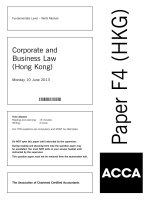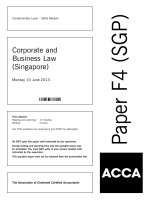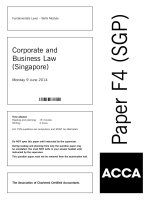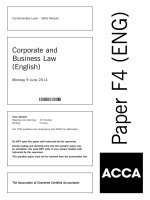Acca f4 corporate and business law russia 2012 jun answer
Bạn đang xem bản rút gọn của tài liệu. Xem và tải ngay bản đầy đủ của tài liệu tại đây (82.67 KB, 10 trang )
Answers
Fundamentals Level – Skills Module, Paper F4 (RUS)
Corporate and Business Law (Russia)
1
June 2012 Answers
The question asked candidates to explain the provisions of the Civil Code in relation to legal capacity. The relevant provisions are
set out in chapter 3 of the Civil Code.
(a)
Passive legal capacity refers to the basic civil rights of any natural legal person. It arises from the moment of birth and
continues until death (article 17).
Article 18 amplifies the nature of passive legal capacity, stating that individuals may possess property, inherit and bequeath
property, engage in activities provided they are not forbidden by law, establish (individually or with others) legal entities, effect
lawful deals, select a place of residence, enjoy rights of authors of works of science, literature and art, inventions and other
intellectual activity, and enjoy other property and non-property rights.
The most fundamental rights associated with passive legal capacity are the rights to a name and a place of residence. The
right to a name includes the right to a surname, given name and patronymic name, conferred by the parents or guardian.
Every individual is entitled to choose a name but must take the necessary steps to inform others for whom there may be a
consequence of this, such as creditors. The place of residence is determined by the parent or guardian until active legal
capacity is attained.
(b)
Active legal capacity is regulated by Articles 21–30 of the Civil Code. Subsequent articles refer to guardianship and
trusteeship.
Active legal capacity refers to the capability of the citizen to acquire and exercise civil rights, to create civil duties and discharge
them. Ordinarily, active legal capacity arises from the age of 18 years. However, it is possible for an individual to marry from
the age of 16 years, in which case article 21 states that the married person will attain active capacity from the date of
marriage. Should the marriage subsequently be dissolved before the age of 18 years, active legal capacity is retained. If the
marriage is declared invalid (as opposed to dissolved), the court may at its discretion deprive the individual of his or her active
legal capacity.
While passive legal capacity entitles the individual to own property (with some exceptions) at any age, the attainment of active
legal capacity entitles transactions to be carried out, such as acquisition or divestment of property.
Active legal capacity entitles the individual to participate in economic activity, such as to be employed or to form a legal entity,
and to acquire rights and obligations.
Article 26 of the Civil Code makes specific provisions in relation to young persons between the ages of 14 and 18 years. They
have the right, without the consent of a parent or guardian, to dispose of their earnings, student grant or other incomes, to
exercise the rights of an author of science, literature or art or an inventor or other intellectual property, make deposits with
financial institutions and dispose of these and to effect deals of low value. With such rights come the responsibilities for the
consequences of such deals.
The court has the right to restrict the active capacity of young persons between the ages of 14 and 18 years if due grounds
are established by the parent or guardian.
Article 27 sets down emancipation provisions under which persons attaining the age of 16 years may be declared to have
full active capacity if he or she engages in business activities with the consent of the parents or guardian, or on declaration
by the court. The young person then bears responsibility for his or her acts.
2
The question asked candidates to explain the essential characteristics of an offer and acceptance.
(a)
The law relating to an offer is set out in Articles 435–437 of the Civil Code.
An offer is a formal proposal by one person or entity to enter into a legally binding contract with one or more other persons
or entities. In order to be regarded as an offer, the Civil Code distinguishes between this and general representations to do
business.
Article 435 states that an offer must be addressed to one or more specific persons, and by inference not to the public in
general. Article 437 goes on to distinguish between the two types of communication. This states that a proposal addressed
to an infinite number of persons is not an offer, but is instead an invitation to make an offer, unless otherwise specifically
provided for in the proposal. However, the same Article goes on to stipulate that such a proposal containing all the essential
terms of the contract will be regarded as making an offer if it is clear that this is the will of the issuer.
For practical purposes, these provisions ensure that those who advertise goods and services or put them on display at
exhibitions or in shop windows are not committed to entering into legal relations should those interested in concluding
business respond by what they consider to be acceptance.
Article 435 goes on to specify that in order to be regarded as an offer, the proposal must be sufficiently comprehensive and
an expression of intent to enter into a contract. The Civil Code does not define what ‘sufficiently comprehensive’ means, but
it is generally recognised that specific references to price, quantity and terms of business are essential in order for the offer to
be regarded as such.
7
Once issued, an offer commits the individual or entity unless it is retracted before or at the same time as it is received by the
counterparty. However, for offers that do not specify a time limit for acceptance, Article 441 states that acceptance must come
either within the time fixed by law, or in the absence of such law, within the ‘normally required time’.
(b)
The law relating to acceptance is set out in Articles 438 et seq of the Civil Code.
Acceptance is defined in Article 438 as a full and unconditional assent by the person or entity to which the offer has been
addressed to the terms set out in the offer.
If the acceptance is conditional or modified, the response does not bring a contract into effect, but forms a counter-offer. This
has two effects. Firstly, it cancels the original offer, which is now no longer capable of acceptance. Secondly, it create a new
offer, which can now be accepted, rejected or ignored by the original offeror (Article 443).
Acceptance may be an explicit communication of assent or an act. In the latter case, this could be, inter alia, the despatch
of goods or provision of services or other behaviour that is consistent with recognition by the offeree of a legally binding
agreement coming into effect.
Acceptance cannot normally be brought about by inaction or silence. However, Article 438 recognises that there may be
exceptions, such as cases of customary business practice, or where the previous conduct of the parties suggests that no
positive action is necessary for acceptance to take place.
Some contracts have to be concluded in a specific manner, such as pledges and conveyances of land. In such cases, the
contract cannot come into effect until the legal formalities (such as the obligation being notarised) have been completed.
As mentioned in part (a), acceptance must take the form of any condition for acceptance stipulated in the offer, including
compliance with the time limit if applicable.
Article 441 states that immediate acceptance of offers made orally brings a legally binding contract into effect.
3
The question asked candidates to explain the form that a labour contract must take, and to explain the terms that must be included
in a labour contract under the provisions of the Labour Code.
(a)
The form of a labour agreement is set out in Article 67 of the Labour Code.
A labour agreement must be concluded in written form. Two copies must be produced, each signed by the employer and the
employee. Each party retains a copy of the agreement.
In the event that the labour agreement is not concluded in the prescribed form, the agreement is nevertheless deemed to
come into effect once the employee commences work having been asked to do so by the employer or a representative of the
employer. In such cases, the employer must draw up a labour agreement within three days of the commencement of work.
(b)
The essential terms that must be included in a labour contract are laid down in Article 57 of the Labour Code.
The contract must include the full names of the parties to the contract, and the date on which the contract comes into effect.
The contract must include the place of work, and if this is situated at a location other than the registered address of the legal
entity, it must refer to the structural unit in which the employee will work.
Details of the formal position of the employee must be set out, including the job title, occupation or specialism and
qualification if appropriate.
The contract must specify the remuneration for the job, broken down where appropriate into basic pay, bonuses and other
payments, non-financial benefits and terms for social insurance. For employees working in hazardous or potentially harmful
environments, the contract must specify any compensation that will be paid for such exposure.
If the working hours and rest periods differ from those generally applicable across the organisation, these must be specified.
The contract generally sets down the rights of obligations of the employer and the employee, though the Labour Code permits
discretion on the precise terms that are included.
4
The question asked candidates to describe the characteristics of a company limited by shares, and to explain the circumstances
under which the owners and managers of a company limited by shares may be held personally liable for its obligations.
(a)
The characteristics of a company limited by shares are set out in Articles 96 and 97 of the Civil Code.
Article 96 defines a company limited by shares as a legal entity in which its authorised capital is divided into a definite
number of shares. The owners of the shares are not generally answerable for the obligations of the company, but are exposed
to the risks associated with the ownership of the shares. The practical effect of this is that the shareholders enjoy limited
liability, and stand to lose only the value of the risk capital they have invested in the enterprise. However, if the shareholder
owes a sum of money to the company in respect of partly paid shares, he or she is liable for the monies outstanding.
A company limited by shares may be formed by one or more persons. The company must have a registered name that
indicates the type of company.
8
Article 97 states that a company limited by shares may take two forms. An open company limited by shares is one in which
the shareholders may dispose of their shares to others without the consent of the other shareholders. The open company may
issue shares by public subscription. A closed company limited by shares is one in which the shares are allotted to specified
persons on the foundation of the company. Closed companies limited by shares are not permitted to issue shares by public
subscription.
The number of shareholders in a closed company limited by shares must not exceed 50 persons. In the event that this number
is exceeded, the closed company must be transformed into an open company within one year, or must be liquidated. Existing
shareholders of a closed company have a pre-emptive right to acquire shares of other shareholders in the company.
Open companies are identified by the prefix OAO, while closed companies are identified by the prefix ZAO.
(b)
The shareholders of a company limited by shares are generally shielded from any exposure to claims against the company
under the principle of limited liability, unless otherwise specified in the Charter of the company. However, it is possible for
the shareholders to bear liability under certain circumstances.
The shareholders may bear liability for contracts entered into prior to the registration of the company. These obligations may
be transferred to the company once it is formed.
In addition, Article 3 of the Federal Law on Companies Limited by Shares states that if a company becomes insolvent, any
shareholders or ‘other persons’ who have the right to give mandatory instructions on behalf of the company may be liable to
the creditors for any action or failure to act in respect of the insolvency. Such liability is subsidiary to the obligations of the
company, which means that the persons concerned would be jointly and severally liable only if the resources of the company
are insufficient to discharge the obligations. In practice, such personal accountability is most likely to arise if the shareholder
or shareholders concerned have a controlling interest or significant influence over the company.
The directors of a company have a duty to manage the company on behalf of the shareholders. Their obligations are defined
in the Civil Code, the Federal Law on Companies Limited by Shares and any relevant provisions set down in the Charter.
Article 53 of the Civil Code states that any person carrying out acts on the company’s behalf must act in the best interests of
the company and must act honestly and wisely. The Article goes on to state that such persons may be held liable by the
founders of the company for any losses inflicted on the company, unless formally indemnified by its constituent documents.
These responsibilities are supported and amplified by Article 71 of the Federal Law on Companies Limited by Shares. This
reiterates the duty of directors to act in the best interests of the company, and goes on to confirm their liability for losses
caused by their actions or inactions. However, directors who voted against decisions that resulted in losses to the company,
or did not participate in such decisions, are not deemed to be liable.
Where such losses are believed to be attributable to the actions or inactions of the directors, the company or its shareholders
have the right to make their case to the court. For a case to be proven, it is up to the claimant(s) to establish that the directors
were at fault.
5
The question tested the candidates’ knowledge of the law relating to extraordinary general meetings of shareholders. It asked
candidates to list the parties that may call for a meeting, to explain the procedure for calling the meeting, and to state the grounds
on which the request to convene a meeting may be refused.
(a)
Article 55 of the Federal Law on Companies Limited by Shares states that an extraordinary general meeting of shareholders
may be convened by the directors, the internal audit commission, an auditor or shareholders owning at least 10% of the
voting shares of the company as at the date of the request.
(b)
Article 55 sets down the procedure for convening an extraordinary general meeting of shareholders.
The responsibility for calling an extraordinary general meeting lies with the directors of the company. In the event that the
functions of the board are fulfilled by the general meeting of shareholders, the responsibility is that of the person designated
to do so on their behalf.
The meeting must be called within 40 days of receipt of the request. A longer period of 70 days applies if the agenda for the
meeting includes a proposal to elect members of the board of directors. If the proposal to elect directors is promulgated by
the board itself, a period of 90 days applies. Shorter periods may be set down in the Charter of the company.
The request to convene an extraordinary general meeting of shareholders must include an agenda setting out matters to be
discussed and the form the meeting should take. The board of directors is not entitled to change the wording of matters
submitted for discussion.
If the request to convene the meeting is submitted by shareholders, the notice must include the names of the shareholders
and details of the quantity and classes of shares that they hold.
The directors must adopt a decision to convene the meeting or refuse to convene it within five days of receipt of the request,
and must advise the party that have proposed the convening of the meeting within three days of the decision.
9
(c)
The directors may refuse to convene an extraordinary general meeting of shareholders if:
(1) The procedure for filing the request for convening the meeting has been violated.
(2) The shareholders requesting the convening of the meeting do not have the necessary shares to authorise them to do so.
(3) The issues proposed for discussion fall outside the scope or responsibility of a meeting.
6
The question tested the candidates’ knowledge of the rights of ordinary shareholders and the rights of preference shareholders.
(a)
The general rights of ordinary shareholders are laid down in Article 31 of the Federal Law on Companies Limited by Shares.
Other Articles in the same legislation expand on the application of these rights.
Holders of ordinary shares have the right to participate in general meetings of shareholders and vote on all matters within the
terms of reference of the meeting. The Charter of the company may make additional provisions in respect of these rights,
provided they are not contrary to the law.
Ordinary shareholders have a right to receive dividends if declared, though no right to vary the dividend recommended by the
directors.
On liquidation of the company, the shareholders have a right to claim the capital invested, though they have no guarantee
that the company will be able to discharge this obligation in full.
Ordinary shares may not be converted into preference shares, bonds or other securities.
Article 40 confers pre-emption rights through which ordinary shareholders must be offered the right to purchase any
additional shares issued by the company.
Article 46 enables shareholders to access the shareholders’ register to confirm his or her rights.
Ordinary shareholders also have the right to receive a copy of the Charter, to inspect the minutes of general meetings, to
receive the financial statements of the company and to petition the court for the winding up of the company.
Certain rights apply to those holding a specified proportion of the shares of a company. Article 53 states that shareholders
owning at least 2% of the voting shares may propose items to be included on the agenda for a general meeting of
shareholders. Article 55 states that shareholders with at least 10% of the voting shares may convene an extraordinary general
meeting.
(b)
The rights of preference shareholders are laid down in Article 32 of the Federal Law on Companies Limited by Shares.
Preference shareholders have a right to a fixed dividend expressed as a fixed sum or as a percentage of the nominal value of
the share. The conditions applicable, and their right to capital distribution in the event of liquidation of the company, are set
down in the Charter. If the company has more than one class of preference share with different terms applicable to each, the
Charter must set down disbursement priorities for both dividends and liquidation value. The Charter may also set down rules
for conversion of preference shares into other types of share. Preference shares may not be converted into bonds.
As a general rule, preference shareholders are not entitled to vote at general meetings. However, they have the right to vote
on proposals to amend the rights attached to their shares, on proposals to liquidate or reorganise the company, and at
meetings following a decision not to pay dividends on their shares.
7
The purpose of this question was to test the candidates’ knowledge of insolvency law relating to the observation process.
(a)
Observation is the monitoring of a company for which insolvency proceedings have been initiated by an interim manager,
appointed by the court of arbitration.
The purposes of observation are to preserve the assets of the company, carry out an analysis of the company’s affairs in order
to ascertain its true financial position, engross the claims of the creditors and convene a meeting of creditors. While the
observation process is under way, all debts of the company are frozen.
The observation process enables the interim manager to determine whether or not the company will be able to meet its
obligations. It may also identify signs of spurious or intentional bankruptcy.
Commencement of the observation process does not mean that liquidation of the company is inevitable. It provides an
opportunity to enable the company to continue trading if there is sufficient evidence to confirm that it may be financially
viable.
(b)
The observation process is laid down in the Federal Law on Bankruptcy.
The interim manager is appointed by the court of arbitration if a company is deemed to be insolvent or if there are indications
of bankruptcy.
The first task of the interim manager is to collect information in respect of the financial position of the company. The company
is obliged to provide the interim manager with all information necessary to complete this task. Information on accounts
payable and receivable is gathered and a list of creditors’ demands is compiled.
10
The interim manager notifies the creditors that an application for insolvency has been submitted and convenes an initial
meeting of creditors. This notice must be issued within five days of appointment. The creditors have 30 days from the receipt
of the official notice to submit their claims and any supporting information.
The Federal Law on Bankruptcy sets down the priority of creditors, so the interim manager has a duty to observe the proper
ranking of claims so that no individual creditors can benefit unduly at a cost to others. It also prevents those with a financial
interest in the company from benefiting personally. In 2009, Federal Law 73-FZ amended the Federal Law on Bankruptcy,
introducing legal remedies against suspicious transactions and preferential transactions, and if these are unearthed by the
interim manager claims may subsequently be pursued against those responsible.
While the observation process is under way, the management of the company may remain in office, though they are obliged
not to obstruct the work of the interim manager in any way. Should they do so, the interim manager may remove their powers
and transfer them to an administrator.
The meeting of creditors may only be attended by those creditors with established claims. Established claims are those which
have been ruled by the court as valid or confirmed by the debtor. The meeting may consider several alternative ways forward.
It may decide to introduce a financial recovery programme (sanation), appointment of an external manager or conclusion of
an amicable settlement (composition). The meeting may of course decide to recognise the bankruptcy of the company and
proceed to receivership. If the creditors’ meeting cannot achieve consensus, the decision on the future course of action lies
with the court of arbitration.
If it becomes apparent during the court of observation that the company will be able to fulfil its obligations, the process is
terminated and the company continues as a going concern.
8
This question asked candidates to apply their knowledge of contract law to a scenario in which contractual obligations had been
performed improperly.
(a)
The scenario concerned an order for a dress and a suit placed by a couple in advance of their wedding. The contract specified
that the garments would be delivered six days in advance of the wedding date, so it is clear that the contract was one in
which time was of the essence. The seller failed to deliver the dress by the specified date, and again failed to meet a further
commitment to deliver. The suit was delivered on time but was of inferior quality.
Article 309 of the Civil Code lays down general provisions concerning the discharge of obligations. It states that obligations
must be discharged in the proper way in conformity with the terms of the agreement and the requirements of law.
The law relevant to the failure to deliver the dress on time is set out in Article 314 of the Civil Code. This obliges the parties
to a contract to discharge the obligation on the particular day specified, or in advance of that day. Although the dress was
eventually delivered, it would be deemed an improper discharge of the obligation to delay the delivery to one day before the
wedding.
Under Article 393 of the Civil Code, –ZAO- Clothes would be liable for losses suffered by the purchaser. These include de
facto losses, which would not only include the consideration paid for the dress but also any additional expenses incurred.
The measure of damages in this instance could include any additional expenditure reasonably incurred to ensure that a similar
dress be available by the day of the wedding ceremony. However, the counterparty has a duty to take reasonable steps to
mitigate losses, so if a much more expensive dress had been purchased as a replacement, the court would limit the value of
any monetary claim submitted.
(b)
In supplying a suit of inferior quality, –ZAO- Clothes was in violation of its responsibilities to perform obligations under the
contract in a proper manner. This offends Article 401 of the Civil Code, which states that a party who fulfils an obligation
improperly shall bear responsibility for this, whether due to ill intent or carelessness. Under the provisions of this Article, the
burden of proof lies with –ZAO- Clothes that all reasonable steps had been taken to fulfil the conditions of the contract.
When considering damages payable to the purchaser, account is taken of the price paid and any losses directly connected
with the improper discharge of the contract. It is clear that the suit had been ordered for a one-off special occasion and that
the defects became apparent on that day. Therefore, the purchaser had no opportunity to substitute the inferior product and
his claim may be limited to the consideration paid for the suit.
9
The purpose of this question was to test the candidates’ ability to apply the principles of partnership law to a situation in which
the partners were in breach of their obligations to one another.
Article 73 of the Civil Code compels the members of a general partnership to act in conformity with the agreement made between
them when the partnership was established. The scenario described two separate breaches of the terms of the partnership.
Anatoly withdrew 500.000 roubles from the partnership account and used the funds for a family holiday. He may therefore be
held liable by the other partners for this unlawful appropriation, and the two other partners may pursue a claim against him.
Depending on the precise details of the transaction, Anatoly could also be held accountable under criminal law for fraud.
As Anatoly had the authority to make the transaction at the bank, the latter acted properly in facilitating the withdrawal, provided
that it did not have any knowledge of his ulterior motive.
11
Bogdana withdrew 750.000 roubles from the partnership account and used this to purchase modern kitchen equipment for sale
in the shop. As the partnership’s business was restricted to dealing in antiques, Bogdana’s transaction was unlawful, and she too
may be held accountable for this by the other partners.
Article 72 of the Civil Code absolves the supplier of modern kitchen equipment of any responsibility for checking that the
transaction conformed to the terms of the partnership agreement, so the transaction cannot be set aside by the other partners.
In relation to the accounts payable that the partnership is unable to discharge, all three partners are liable for these on a joint and
several basis, as Article 75 of the Civil Code states that all partners bear subsidiary liability for the obligations of the partnership
with all their wealth. Therefore, even though Valeriya was an innocent party in respect of the irregular transactions that may have
weakened the partnership’s financial position, her liability for the obligations of the partnership is no less than that of her partners.
10 The question tested the ability of candidates to apply their knowledge of the rights and obligations of the shareholders of an open
company limited by shares to a scenario in which a shareholder sought to gain a more influential position in the company by
acquiring further shares.
(a)
At the outset, three siblings owned 20% of the voting shares in the company, with a further 6% of the shares being held by
their parents.
Alexander sought to purchase the 20% stake held by Yevgeni, and a further 11% stake held by minor shareholders in the
company. Article 97 of the Civil Code enables the shareholders to dispose of their shares at will, without the consent of other
shareholders. Alexander therefore has a right to go ahead with these acquisitions of further shares. His aggregate holding of
shares would therefore be 51% of the total equity in the company, giving him a constitutional right to take any decision
unilaterally, except in those cases where the law requires a super-majority vote of 75% in favour of a proposal.
Both the acquisition of Yevgeni’s shares and the further purchase of shares from minor shareholders trigger obligations under
the controlling interest rules set down in the Federal Law on Companies Limited by Shares. Article 84 of this law states that
should a proposed acquisition of shares take the aggregate shares held by the investor to 30% of the total voting shares in
the company, the investor must offer the opportunity to other shareholders to sell their shares to him.
Further, this obligation extends to any further tranches of 5% of the voting shares subsequently acquired. Applying this to the
case, all other shareholders would have the option to sell their shares to Alexander at a fair price, which might be considered
by Maria, given her imminent dilution of influence in the company and her strong opposition to Alexander’s plans for its future.
Alexander could avoid the obligation to make a general offer if there is a provision in the Charter to this effect, or if the
shareholders sanction this by simple majority.
(b)
If Alexander’s proposed transactions were to go ahead, this would greatly weaken the position of Maria, Igor and Svetlana,
even if they did not agree to sell their shares to Alexander. Collectively they would hold 26% of the voting shares in the
company. However, various powers remain at their disposal.
As they each hold in excess of 2% of the shares, they would be able to place items on the agenda of any general meeting of
shareholders.
Acting on her own, or in collaboration with her parents, Maria would be able to convene an extraordinary general meeting of
shareholders, as she holds more than 10% of the voting shares. This would only empower them to block any resolution that
required a super-majority vote in favour, but as the company has a large number of minor shareholders, any concerted action
to oppose Alexander’s plans could have a significant effect on the value of the shares.
Crucially, if the company’s Charter does not accommodate Alexander’s plans, such as having provisions that restrict the
objects of the company, he may be unable to pursue his plans, as any changes to the Charter require a super-majority vote,
which could not be achieved if Maria, Igor and Svetlana refuse to support him.
12
Fundamentals Level – Skills Module, Paper F4 (RUS)
Corporate and Business Law (Russia)
1
2
3
4
June 2012 Marking Scheme
(a)
Definition of passive legal capacity
Rights associated with passive legal capacity
1 mark
Up to 2 marks
(3 marks)
(b)
Definition of active legal capacity
Rights and obligations associated with active legal capacity
Specific provisions relating to those aged 14–18 years
Emancipation provisions
Withdrawal of active legal capacity
1 mark
Up to 2 marks
Up to 2 marks
1 mark
1 mark
(7 marks)
(10 marks)
(a)
Offer made to one or more specific persons
Sufficiently definite
Time limit and effect
Offer distinguished from public offer
Right to withdraw/recall offer
1 mark
Up to 2 marks
1 mark
1 mark
1 mark
(maximum 5 marks)
(b)
Full and unconditional assent
Effect of counter-offer
Agreement to terms of offer or positive act
Inaction or silence
Time limit and effect (if not covered in part (a))
1 mark
Up to 2 marks
1 mark
1 mark
1 mark
(maximum 5 marks)
(10 marks)
(a)
Written form
Two copies with signatures
Implications of not providing written contract
1 mark
1 mark
1 mark
(3 marks)
(b)
Names of parties and date
Location
Position and occupation
Remuneration and related matters
Working hours and rest periods
Rights and obligations of parties
1 mark
1 mark
1 mark
Up to 2 marks
1 mark
1 mark
(7 marks)
(10 marks)
(a)
Separate legal entity
Authorised capital divided into shares
Limited liability
Features of open and closed companies
1 mark
1 mark
1 mark
Up to 3 marks
(6 marks)
(b)
Liabilities of owners
Liabilities of directors
Up to 2 marks
Up to 2 marks
(4 marks)
(10 marks)
13
5
6
7
8
9
(a)
Directors
Internal audit commission
Auditor
Shareholders
0·5 mark
0·5 mark
0·5 mark
0·5 mark
(2 marks)
(b)
Responsibility of directors
Notice periods
Agenda
Details of shareholders
Adoption of decision to convene meeting
1 mark
1 mark
1 mark
1 mark
1 mark
(5 marks)
(c)
Each ground for refusal to convene meeting
1 mark
(3 marks)
(10 marks)
(a)
Right to dividends if declared
Constitutional rights
Rights to information
Rights subject to share ownership thresholds
1 mark
Up to 2 marks
1 mark
Up to 2 marks
(6 marks)
(b)
Right to dividend
Rights to vote
Rights of conversion
1 mark
Up to 2 marks
1 mark
(4 marks)
(10 marks)
(a)
Definition of observation
Purposes of observation
1 mark
Up to 3 marks
(4 marks)
(b)
General duties of interim manager
Implications for existing management
Creditors’ meeting
Outcomes of observation
Up to 2 marks
1 mark
Up to 2 marks
1 mark
(6 marks)
(10 marks)
(a)
Discharge of contract in proper time
Damages
Duty to mitigate
Application to scenario
1 mark
1 mark
1 mark
Up to 2 marks
(5 marks)
(b)
Failure to discharge/improper discharge of obligation
Damages
Application to scenario
Up to 2 marks
1 mark
Up to 2 marks
(5 marks)
(10 marks)
Statement of provisions of Civil Code
Analysis of unlawful bank transaction and implications
Analysis of unlawful purchase of inventory
Obligations of partners for individual transactions
Joint and several liability for accounts payable
Up to 2 marks
Up to 2 marks
Up to 2 marks
Up to 2 marks
Up to 2 marks
(10 marks)
14
10 (a)
(b)
Right to freely dispose of shares
Implications of acquisition of shares for control of company
General offer provisions
Specific reference to 30% and 5% thresholds
1 mark
Up to 2 marks
1 mark
Up to 2 marks
(6 marks)
Right to place items on agenda of general meeting
Right to call general meeting
Ability to limit resolutions
Ability to prevent changes to Charter
1 mark
1 mark
1 mark
1 mark
(4 marks)
(10 marks)
15









